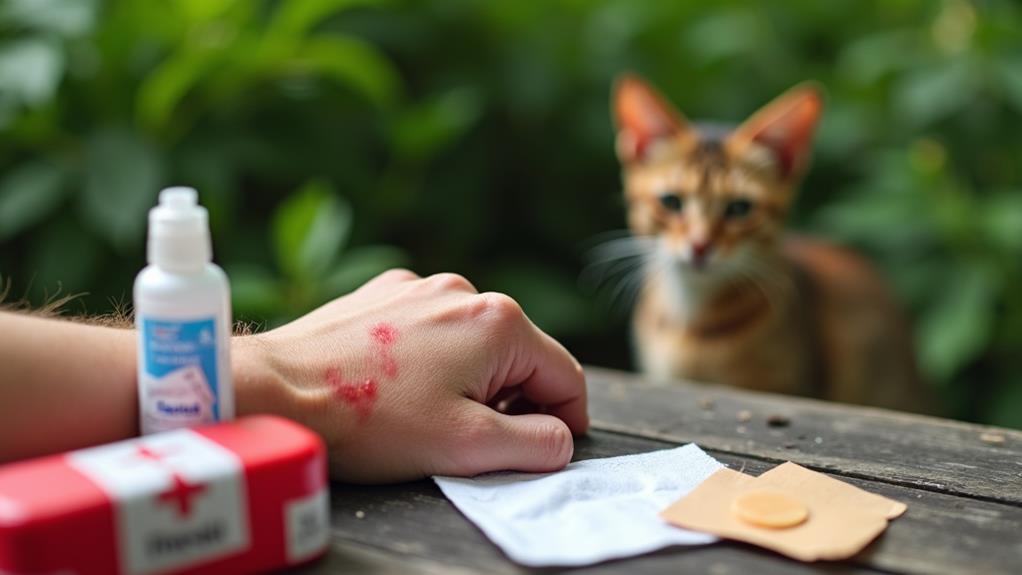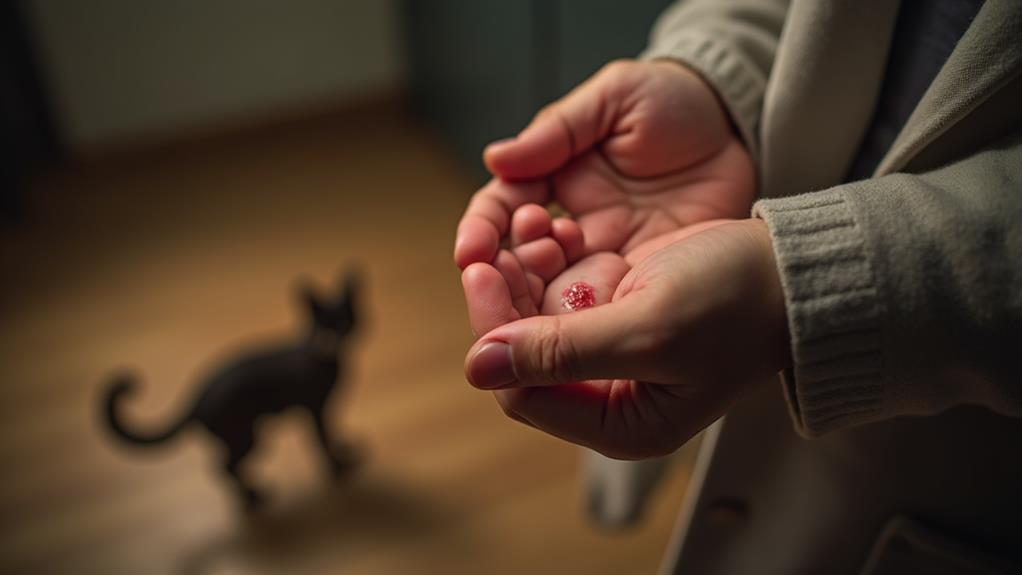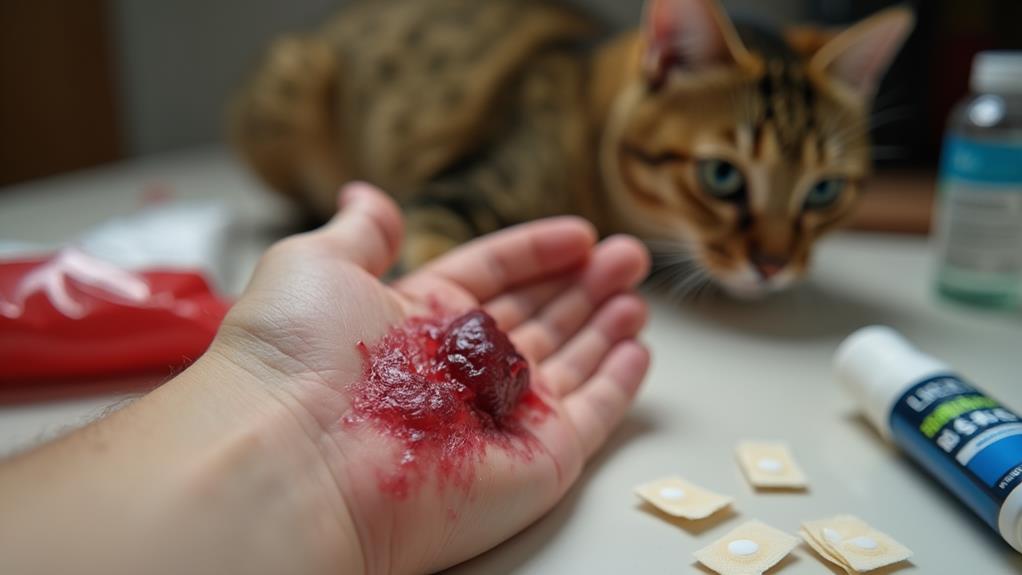What to Do If a Feral Cat Scratches You: Treatment and Precautions

If a feral cat scratches you, immediately wash the wound under running water for five minutes. Clean with soap or a mild saline solution. Stop any bleeding by gently pressing a sterile gauze pad, then apply antiseptic and an antibiotic ointment. Cover with a sterile bandage. Watch for signs of infection like redness, swelling, or fever over the next days. If you notice any infection symptoms or if the scratch is deep, contact a healthcare provider. It's also essential to take into account possible diseases like Cat Scratch Disease and rabies. There's a lot more to guarantee you stay safe after such an incident.
Immediate First Aid Steps
When dealing with a feral cat scratch, the initial vital step is to wash the wound gently under running water for at least five minutes. This essential first aid measure helps to remove dirt and bacteria, greatly reducing the risk of infection. Once you've thoroughly rinsed the scratch, the next step is to clean it with soap or a mild saline solution, which you can make by mixing one teaspoon of salt in two cups of water. Make sure to rinse the area thoroughly again to eliminate any remaining contaminants.
After cleaning, control any bleeding by applying gentle pressure with a sterile gauze pad. It's important to disinfect the area with an antiseptic solution to further protect against infection. Once the bleeding has stopped and the wound is clean, apply an over-the-counter antibiotic ointment. This step adds an extra layer of protection against bacteria. Ultimately, cover the scratch with a sterile bandage to keep it clean and shielded from potential irritants.
These immediate first aid steps are vital to minimizing the risk of infection from cat scratches. Always monitor the scratch closely and be alert for any signs of infection.
Recognizing Infection Signs
After administering immediate primary aid to a feral cat scratch, it's vital to stay vigilant for any signs of infection. Within 3 to 10 days post-injury, watch for increasing redness, swelling, and tenderness around the scratch. These early indicators can signify that the area isn't healing properly and needs attention. If you notice pus or any drainage from the wound, it's a strong indication of infection, and you should seek medical help promptly.
Along with local symptoms, keep an eye out for systemic signs like flu-like symptoms. Fever, headache, fatigue, and a poor appetite can develop, especially if your immune system is compromised. These symptoms might suggest cat scratch fever, a condition that can arise from an infected scratch.
Another significant sign to monitor is the presence of swollen lymph nodes, particularly near the scratch site. For instance, if the scratch is on your arm, you might notice swelling under your arm or in the groin area. This could indicate that the infection is spreading. If any of these symptoms persist for more than 2-3 weeks or worsen, it's important to consult a healthcare professional for further evaluation and treatment options.
Understanding Cat-Scratch Disease

Understanding cat-scratch disease (CSD) is crucial, especially if you're regularly in contact with cats. CSD is a bacterial infection caused by Bartonella henselae, commonly transmitted through scratches or bites. This bacteria often finds its way to you via infected cats, usually those with flea infestations. If you're scratched by a feral or domestic cat, be aware that symptoms of CSD typically appear within 3 to 10 days. These symptoms include a small, red bump at the scratch site, swollen lymph nodes, low-grade fever, fatigue, and headaches.
Around 12,000 outpatient cases arise annually in the U.S., with children and immunocompromised individuals being more susceptible. Diagnosing CSD can be tricky. It often involves a thorough medical examination and symptom review. If symptoms persist, your doctor might recommend blood tests to confirm the diagnosis.
While CSD generally isn't severe for healthy individuals, it can lead to complications for those with weakened immune systems. If you notice symptoms worsening, seek medical attention promptly. Being aware of CSD and its symptoms can help you act quickly, ensuring that any potential health issues are addressed efficiently.
Rabies Concerns and Actions
Rabies is a serious concern to be aware of, especially if you're dealing with feral cats. While domestic cats rarely transmit the virus, it's still significant to be cautious. If a feral cat scratches you, and its rabies vaccination status is unknown, or it appears sick or behaves unusually, you should seek medical attention immediately. Rabies is a fatal viral disease primarily spread through the saliva of infected animals, and early symptoms can mimic the flu, like fever and headache, which progress to severe neurological issues.
Once you're scratched by a potentially infected cat, acting quickly is vital. Post-exposure prophylaxis (PEP) is nearly 100% effective if administered promptly after exposure. This treatment includes rabies vaccinations and immunoglobulin injections, which can prevent the virus from taking hold in your body. Don't wait for symptoms to appear, as they develop rapidly, making timely medical intervention essential for your safety.
Educating yourself and your community about rabies risks and prevention is important. Vaccinating your pets and understanding safe interactions with feral cats can significantly reduce the chances of a rabies exposure, keeping both you and your community safer.
Other Possible Infections

While rabies is a significant concern when dealing with feral cats, it's not the only infection to be aware of. Feral cat scratches can transmit numerous bacteria, leading to infections that require your attention. Pasteurella multocida, commonly found in a cat's mouth, can cause serious infections if not treated promptly. This bacteria can lead to severe complications, including abscess formation, necessitating surgical intervention.
Another potential risk is Methicillin-resistant Staphylococcus aureus (MRSA), particularly if you have a compromised immune system or open wounds. MRSA infections can be challenging to treat due to their resistance to antibiotics, making early detection and care vital.
Cat-scratch disease, caused by Bartonella henselae, is another infection to watch out for. This disease can occur from scratches, presenting symptoms such as fever, headache, and swollen lymph nodes. Left untreated, cat-scratch disease can lead to more severe health issues.
To prevent these infections, clean the scratch immediately and thoroughly. Use soap and water, and then apply an antiseptic. Monitoring for signs of infection, like redness, swelling, or increased pain, is imperative. Early intervention is key to avoiding severe complications from these bacterial infections.
When to Seek Medical Help
Recognizing the signs that warrant medical attention after a feral cat scratch is essential for your health. If the scratch or bite is deep, bleeding profusely, or if you notice symptoms of infection, don't hesitate to seek medical help. Infections can develop rapidly, so prompt attention is imperative. Watch for persistent flu-like symptoms, including fever, headache, or fatigue, as these might indicate cat-scratch disease—a bacterial infection transmitted by cats.
Here's when you should seek medical help:
- Persistent flu-like symptoms: Fever, headache, or fatigue lasting several weeks.
- Signs of infection at the scratch site: Increased redness, swelling, or pus.
- Swollen lymph nodes: Painful swelling near the scratch site.
- Weak immune systems: If you have underlying health conditions or are immunocompromised, you face an increased risk of complications.
Consider seeking a rabies vaccination and post-exposure prophylaxis if you're unsure about the cat's vaccination status or if the feral cat acted erratically. Your health should always take precedence, so consulting a healthcare professional guarantees you're taking the right steps. Remember, dealing with potential infections early can prevent more serious health issues down the line.
Prevention Tips for Cat Interactions

Taking proactive steps to prevent injuries during cat interactions is just as vital as knowing when to seek medical care. To begin with, always wash your hands thoroughly with soap and water after handling cats. This simple habit reduces the risk of bacterial transmission, especially if you get scratched or bitten. Remember, cleanliness helps in keeping potential infections at bay.
When playing with a cat, engage in gentle play. Avoid roughhousing or teasing, as these can lead to scratches or bites. Cats are more likely to scratch if they feel threatened or overstimulated, so keeping playtime calm and controlled is key.
Trim your cat's claws regularly. Shorter claws lessen the severity of potential scratches and reduce the risk of injury during play. If you're unsure how to trim claws safely, ask your veterinarian for guidance.
Also, don't let cats lick open wounds or areas near your mouth and nose. This behavior can introduce bacteria into your bloodstream, increasing the risk of infection. Finally, control flea populations in your home and on your pets. Fleas can carry harmful bacteria, so regular veterinary care and flea treatments are fundamental.
Minimizing Risks in the Future
Prevention is key with regard to minimizing risks associated with feral cats. When you're proactive, you can greatly reduce the risk of injury or infection. Start by always washing your hands thoroughly after handling any cats, especially feral ones. Their saliva and fur can harbor bacteria that could enter open wounds. Also, limit direct interactions with feral cats. They aren't as accustomed to human contact and may react defensively by scratching or biting.
Consider these steps to further protect yourself:
- Wear gloves when dealing with feral cats or cleaning their areas. This creates a barrier against possible scratches or bites.
- Use humane traps to safely capture and manage feral cats. Handling them directly increases the likelihood of injury.
- Keep your pets' vaccinations and flea treatments up-to-date. This helps reduce the risk of infections transmitted from feral cats.
- Consult a healthcare provider if a scratch occurs. They can assess the situation and provide appropriate care.
Educating the Community

While minimizing risks associated with feral cats is vital, it's likewise significant to focus on educating the community about these issues. By raising awareness, you can help prevent cat scratches and bites, reducing the risk of infection. Community education programs should emphasize avoiding contact with feral cats and highlight the importance of recognizing signs of illness. Understanding symptoms of Cat Scratch Disease, such as swollen lymph nodes or fever, can prompt you to seek medical attention early, reducing complications.
Providing resources on safe handling practices is important. Learning how to interact safely or avoid interaction entirely can decrease the likelihood of aggressive encounters. Encouraging spaying and neutering efforts helps control feral cat populations, which in turn reduces potential conflicts. Sharing information on local animal control services empowers you to report or manage feral cat situations responsibly.
Workshops focusing on initial aid for cat scratches are invaluable. They teach you proper wound care techniques, helping to prevent infections. By attending these sessions, you'll be better equipped to handle any unexpected encounters. Educating the community not only protects you but also guarantees a healthier coexistence with feral cats.




